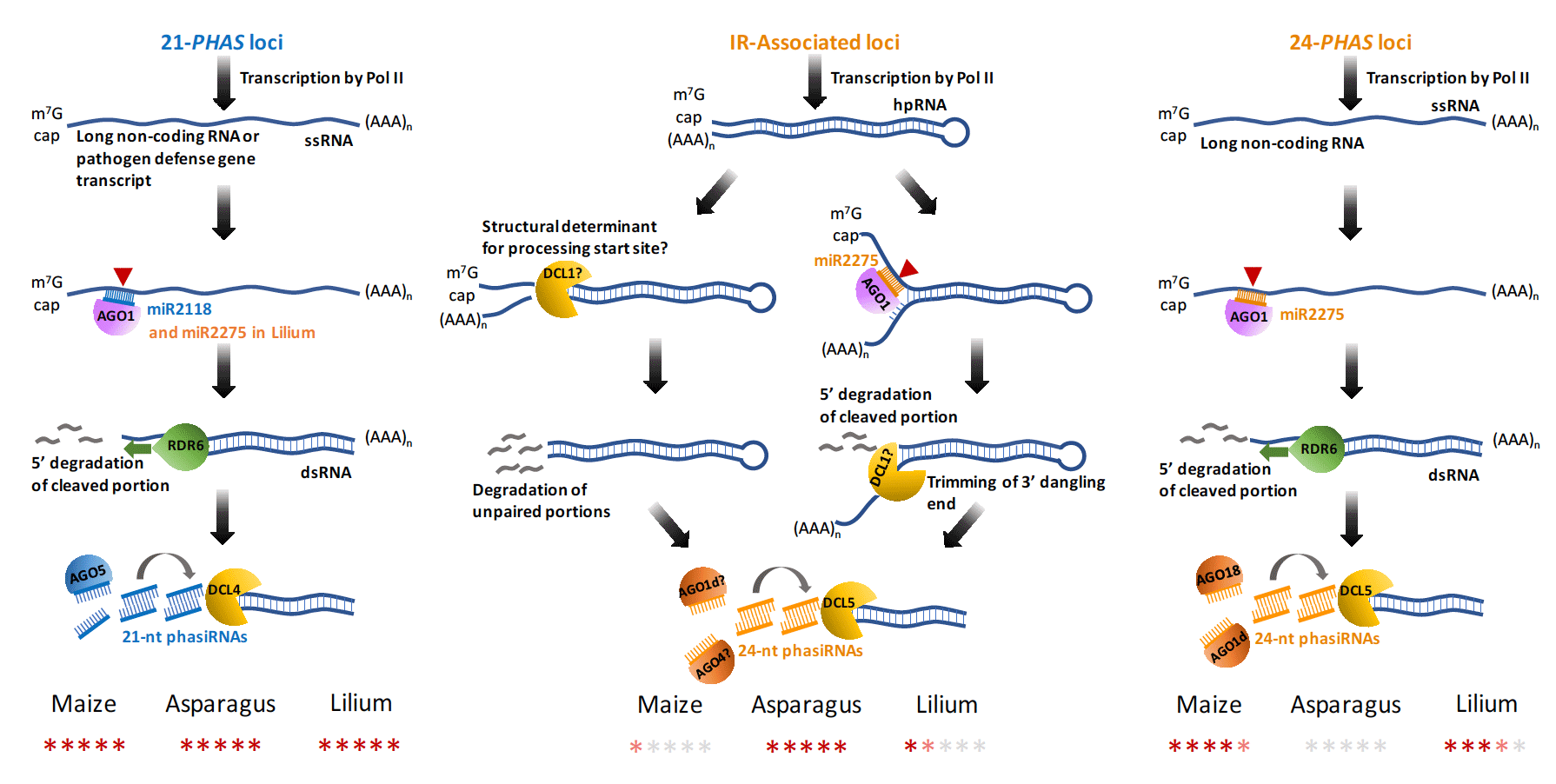博文
Genome Research:单子叶植物24核酸phasiRNA的起源与演化
||
Plant 24-nt reproductive phasiRNAs from intramolecular duplex mRNAs in diverse monocots
First author: Atul Kakrana; Affiliations: University of Delaware (特拉华大学): Newark, USA
Corresponding author: Blake C. Meyers
In grasses, two pathways that generate diverse and numerous 21-nt (premeiotic; 减数分裂前) and 24-nt (meiotic; 减数分裂间) phased siRNAs are highly enriched in anthers, the male reproductive organs. These “phasiRNAs” are analogous to mammalian piRNAs, yet their functions and evolutionary origins remain largely unknown. The 24-nt meiotic phasiRNAs have only been described in grasses, wherein their biogenesis is dependent on a specialized Dicer (DCL5). To assess how evolution gave rise to this pathway, we examined reproductive phasiRNA pathways in nongrass monocots: garden asparagus (芦笋), daylily (黄花菜), and lily (百合). The common ancestors of these species diverged approximately 115–117 million years ago (MYA). We found that premeiotic 21-nt and meiotic 24-nt phasiRNAs were abundant in all three species and displayed spatial localization and temporal dynamics similar to grasses. The miR2275-triggered pathway was also present, yielding 24-nt reproductive phasiRNAs, and thus originated more than 117 MYA. In asparagus, unlike in grasses, these siRNAs are largely derived from inverted repeats (IRs); analyses in lily identified thousands of precursor loci, and many were also predicted to form foldback substrates for Dicer processing. Additionally, reproductive phasiRNAs were present in female reproductive organs and thus may function in both male and female germinal development. These data describe several distinct mechanisms of production for 24-nt meiotic phasiRNAs and provide new insights into the evolution of reproductive phasiRNA pathways in monocots.
禾本科植物中有两个通路生成各种各样的减数分裂前21nt和减数分裂间24nt的phased siRNA,这些phasiRNA在雄性生殖器官花药中高度富集。这些phasiRNA与哺乳动物的piRNA同源,但它们的功能及演化起源仍然不清楚。24nt的减数分裂间phasiRNA仅在禾本科植物中有报道,其生物合成依赖于特化的Dicer蛋白DCL5。为了搞清楚这条生成24nt的phasiRNA的通路是如何演化形成的,作者对芦笋、黄花菜及百合等非禾本科植物的生殖phasiRNA通路进行了研究。这些物种的祖先大概在115-117个百万年前分化。作者发现减数分裂前21nt的phasiRNA和减数分裂间24nt的phasiRNA在这三个物种中都有富集,并且与禾本科植物表现出类似的空间定位与时间动态变化。产生24nt的生殖phasiRNA的miR2275诱导通路同样在这三个物种中存在,说明该通路至少起源于117百万年之前。在芦笋中,不像禾本科植物中一样,这些siRNA大部分源自于反向重复,而在百合中的分析鉴定到了数千个前体位点,并且大多数是Dicer生物过程的底物。另外,生殖phasiRNA在雌性生殖器官中也存在,因此可能在雄性和雌性发育过程中均能发挥作用。本文的研究描述了几种产生24nt的phasiRNA的不同机制,另外为单子叶植物中生殖phasiRNA通路的演化提供了新的视野。
通讯:Blake C. Meyers (https://www.danforthcenter.org/scientists-research/principal-investigators/blake-meyers)
研究方向:RNA沉默通路上的组分元件;植物生殖生物学;植物小RNA的演化;高通量测序等。实验室网址:http://www.meyerslab.org/index.php。
doi: 10.1101/gr.228163.117
Journal: Genome Research
Published date: 30 July, 2018
(P.S. 原文下载:链接:https://pan.baidu.com/s/1qFiSsqwlF_7JjmGMbedfhQ 密码:dmu6)
https://blog.sciencenet.cn/blog-3158122-1128241.html
上一篇:NAT ECOL EVOL:草食动物与寄主植物互作的分子基础
下一篇:Plant Cell:矮牵牛与拟南芥蜜腺发育的分子基础
全部作者的其他最新博文
- • Plant Physiology:CsMADS3促进柑果中的叶绿素降解和类胡萝卜素合成(华中农业大学)
- • Molecular Plant:LBD11-ROS反馈调节作用于拟南芥的维管形成层增殖和次生生长(浦项科技大学)
- • Science Advances:根结线虫通过调控植物的CLE3-CLV1模块,促进侵染进程(日本熊本大学)
- • Nature Communications:油菜素内酯参与植物营养生长期转变的分子机制解析(浙江农林大学)
- • Current Biology:光合作用产生的蔗糖驱动侧根“生物钟”(德国弗莱堡大学)
- • PNAS:花同源异型基因在叶中被抑制、花中被激活的分子机制(南卡罗来纳大学)


